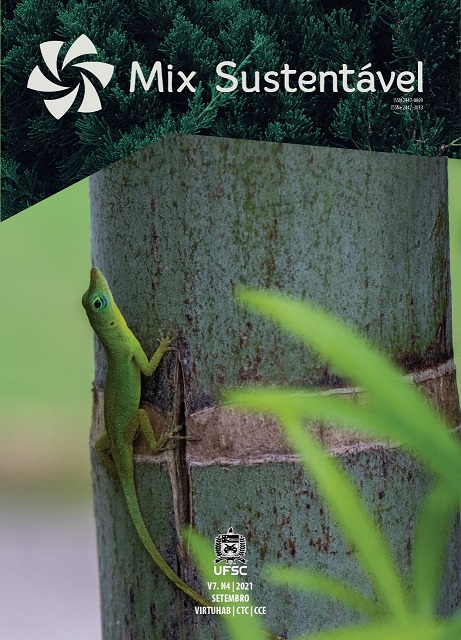COMPARAÇÃO DE BIOMASSA VEGETAL E ANIMAL EM BIOARGAMASSA
DOI:
https://doi.org/10.29183/2447-3073.MIX2021.v7.n4.31-38Palavras-chave:
Biocementation, Biomineralization, Bio-mortar, Organic matter, Sporosarcina pasteurResumo
O uso de microrganismos em meio líquido para o processo de biocimentação, favorece a continuidade do crescimento bacteriano. Entretanto se este demora para ser usado, para de crescer rapidamente, levando a morte celular. Este estudo comparou duas formas de produção de uma biomassa, capaz de armazenar os microrganismos em estado de latência mantendo a viabilidade para posterior utilização. Aqui foi descrito o preparo de biomassas, feitas com materiais orgânicos e bactéria Sporosarcina pasteurii (CCT 0538 ATCC 1185). Foram testadas biomassas de origem animal (esterco de aves) e vegetal (ervilhaca - Vicia villosa Roth). Ambas biomassas mantiveram a viabilidade dos microrganismos, sendo que a vegetal foi mais eficiente apresentando maior crescimento bacteriano após a revitalização. Para teste foram moldados corpos de prova referência (sem biomassa) e também com cada uma delas, e depois de 28 dias ensaiados a tração e compressão. A resistência a tração apresentou um aumento de 41,2 % (biomassa animal) e de 44,7 % (biomassa vegetal). Na resistência a compressão o aumento foi de 37,8 % (biomassa animal) e de 38,8 % (biomassa vegetal), comparados a argamassa de referencia (sem adição de microrganismo).Referências
ACHAL, Varenyam; MUKERJEE, Abhijeet. A review of microbial Precipitation for sustainable construction. Construction and Building Materials. Vol. 93, may 2015, pg. 1224-1235. doi.org/10.1016/j.conbuildmat.2015.04.051. Disponível em: <https://www.sciencedirect.com/science/article/pii/S0950061815005000>. Acesso em: 24 jun. 2016.
AFIFUDIN, H. et al. (2011). Microbial participation in the formation of calcium silicate hydrated (CSH) from bacillus subtilis. Paper presented at the Procedia Engineering, , 20 159-165. doi:10.1016/j.proeng.2011.11.151
ASSOCIAÇÃO BRASILEIRA DE NORMAS TÉCNICAS. 13279: Argamassa para assentamento e revestimento de paredes e tetos - Determinação da resistência à tração na flexão e à compressão. 1 ed. Rio de Janeiro: Moderna, 2005.
BHADURI, Swayamdipta; DEBNATH, Nandini; MITRA, Sushanta; LIU, Yang; KUMAR, Aloke. Precipitação de calcite induzida microbiologicamente mediada por Sporosarcina pasteurii. Journal of Visualized Experiments. 2016; (110): 53253. Doi: 10.3791/53253. Disponível em <https://www.ncbi.nlm.nih.gov/pubmed/27167458>. Acesso em: s03 set. 2019.
BANG, Sookie S.; GALINAT, Johnna K.; RAMAKRISHNAN, V.. Calcite precipitation induced by polyurethane-immobilized Bacillus pasteurii. Enzyme And Microbial Technology, Rapid City, v. 28, n. 2, p.402-409, 17 out. 2000. Disponível em:
. Acesso em: 17 out. 2000.
COSTA, João José Soares. Biotecnologia e Biomimetismo: Contributos Inovadores para a Ecoeficiência da Indústria da Construção. Dissertação de mestrado em Engenharia Civil. Universidade do Minho. Braga, Portugal, 2014. Disponível em:
<http://repositorium.sdum.uminho.pt/handle/1822/36246>, acesso em: 22 fev. 2016.
DE MUYNCK, Willem; DE BELIE, Nele; VERSTRAETE, Willy. Microbial carbonate precipitation in construction materials: A review. Eccological Engineering 36, pg. 118-136. Belgium, 2010.
DHAMI, N. K. et al. (2013). Viability of calcifying bacterial formulations in fly ash for applications in building materials. Journal of Industrial Microbiology and Biotechnology, 40(12), 1403-1413. doi:10.1007/s10295-013-1338-7
FERREIRA, Paulo Ademar Avelar et al. Biomass decomposition and nutrient release from black oat and hairy vetch residues deposited in a vineyard. Revista Brasileira de Ciência do Solo, Bento Gonçalves, v. 1, n. 38, p. 1621-1632, fev. 2014.
IVANOV, V. K. et al. (2016). Using extraction and sorption processes to obtain nanosized powders of calcium silicates and functional materials on their basis. Theoretical Foundations of Chemical Engineering, 50(4), 490-497. doi:10.1134/S0040579516040023. Disponível em:
MCIP (org.). Ministério da Ciência, Tecnologia, Inovações e Comunicações. 2014. Disponível em:
<https://antigo.mctic.gov.br/mctic/opencms/institucional/paginaInstitucional.html>. Acesso em: 02 fev. 2014.>
RAMAKRISHNAN, V.. Performance characteristics of bacterial concrete - A smart biomaterial. Anais da 1ª Conferência Internacional sobre Recentes Avanços na Tecnologia do Concreto, RAC 2007, Páginas 67-78. 1ª Conferência Internacional sobre Avanços Recentes na Tecnologia do Concreto, RAC 2007; Sheraton em Crystal City Washington; Estados Unidos; 19 a 21 de setembro de 2007; Código 111076. Disponível em:<https://www.tib.eu/en/search/id/tema%3ATEMA20080507849/Performance- characteristics-of-bacterial-concrete/>. Acesso em: 28 abr. 2018.
SANTINATO, R. et al. Doses de esterco de peru na substituição parcial – proporcional das adubações NPKS mineral na produção do cafeeiro. In: CONGRESSO BRASILEIRO DE PESQUISAS CAFEEIRAS, 38., 2012, Caxambu. Anais... Brasília, DF: Embrapa Café, 2012. (1 CD-ROM), 2 p. <https://www.sciencedirect.com/science/article/pii/S0950061815005000>. Acesso em: 24 jun. 2016.
Downloads
Publicado
Edição
Seção
Licença
Aviso de Direito Autoral Creative Commons
1. Política para Periódicos de Acesso Livre
Autores que publicam nesta revista concordam com os seguintes termos:
a. Autores mantém os direitos autorais e concedem à revista o direito de primeira publicação, com o trabalho simultaneamente licenciado sob a Licença Creative Commons Attribution que permite o compartilhamento do trabalho com reconhecimento da autoria e publicação inicial nesta revista.
b. Autores têm autorização para assumir contratos adicionais separadamente, para distribuição não-exclusiva da versão do trabalho publicada nesta revista (ex.: publicar em repositório institucional ou como capítulo de livro), com reconhecimento de autoria e publicação inicial nesta revista.
c. Autores têm permissão e são estimulados a publicar e distribuir seu trabalho online (ex.: em repositórios institucionais ou na sua página pessoal) a qualquer ponto após o processo editorial, já que isso pode gerar alterações produtivas, bem como aumentar o impacto e a citação do trabalho publicado (Veja O Efeito do Acesso Livre).




